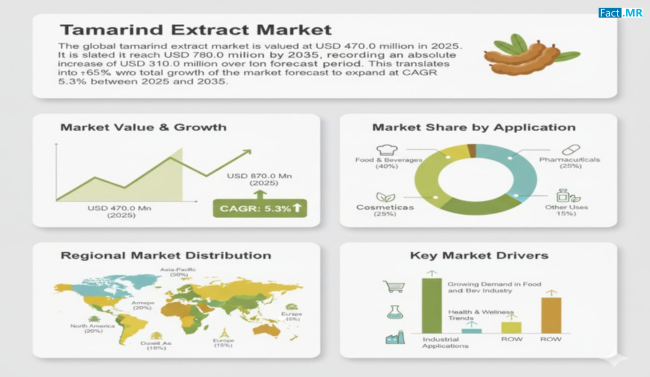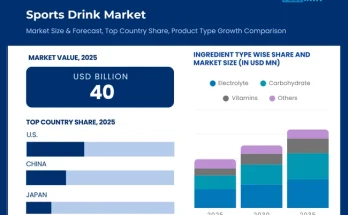The growing preference for natural ingredients in food, beverages, cosmetics, and pharmaceuticals is driving the demand for tamarind extract globally. Known for its unique flavor profile, nutritional value, and medicinal properties, tamarind extract is emerging as a versatile ingredient across industries. Its multifunctionality—ranging from culinary applications to health and personal care—positions it as a key ingredient in the natural extracts market.
Market Overview:
Tamarind extract is derived from the pulp, seeds, and sometimes the oil of tamarind fruit. It is widely valued for its sour taste, antioxidant content, and high levels of vitamins, especially vitamin C. This extract finds extensive use in food seasonings, sauces, beverages, confectionery, and even as a natural preservative due to its antimicrobial properties. Beyond culinary use, tamarind extract is increasingly incorporated in cosmetics for skin and hair care and in pharmaceuticals for its therapeutic benefits.
Regional Insights:
Asia-Pacific dominates the tamarind extract market, driven by high consumption of tamarind in daily diets and its traditional medicinal applications. India and Indonesia are prominent producers, leveraging their abundant natural resources and established processing infrastructure. North America and Europe are witnessing growing demand due to rising health consciousness, the popularity of natural beverages, and the adoption of plant-based ingredients in personal care and wellness products. These regions are also seeing growth due to increasing incorporation of tamarind extract in functional foods and nutraceuticals.
Key Trends & Forecast:
- Natural Preservatives:With rising consumer awareness about chemical additives, tamarind extract is increasingly used as a natural preservative in food and beverage products. Its antimicrobial, antiseptic, and antifungal properties enhance shelf life while maintaining safety.
- Health and Wellness Focus:The extract’s rich vitamin content and antioxidant properties are driving its use in dietary supplements, health drinks, and functional beverages. Its role in supporting immunity and digestion continues to fuel market growth.
- Cosmetic Applications:Tamarind extract is being incorporated in skincare and haircare formulations due to its moisturizing, brightening, and anti-aging properties. The trend of plant-based cosmetics is providing new growth avenues.
- Product Innovation and Diversification:Manufacturers are exploring new forms of tamarind extract, including powders, pastes, and concentrates, and combining it with other natural ingredients to enhance functionality and appeal.
- Consumer Preference Shifts:Busy lifestyles are increasing demand for convenient, ready-to-use tamarind extracts in both food and beverages, supporting broader adoption across markets.
Applications & End-Use Outlook:
Tamarind extract has extensive applications across multiple industries. In the food sector, it is used in seasoning, sauces, condiments, confectioneries, and as a flavoring agent. The beverage industry incorporates tamarind extract in juices, soft drinks, wines, and specialty alcoholic beverages, leveraging its distinctive taste and nutritional benefits. In cosmetics, tamarind extract is valued for skin hydration, hair care, and anti-aging products. Pharmaceuticals use it in health supplements, syrups, and therapeutic formulations. Its multifunctionality ensures that diverse sectors continue to adopt and innovate with tamarind extract.
Challenges in Market Growth:
Despite its advantages, the tamarind extract market faces challenges. Supply chain disruptions, influenced by factors like deforestation, urbanization, and seasonal variations, can impact production. High labor requirements for processing, coupled with infrastructure needs, may constrain manufacturers. Additionally, government regulations and import-export policies in some regions can affect market dynamics. Addressing these challenges is critical for sustaining growth and meeting increasing demand.
Company Strategies and Market Leadership:
Key players in the tamarind extract market are focusing on innovation, quality assurance, and expanding distribution networks. Companies are differentiating products through purity, flavor, and form—ranging from powder to paste and concentrate. Branding, transparency in labeling, and product promotion are becoming crucial factors to gain consumer trust. Manufacturers are also investing in research to develop new applications and enhance the extract’s functionality in food, beverage, health, and personal care sectors.
Conclusion:
The tamarind extract market is poised for significant growth, driven by consumer preference for natural, functional, and plant-based ingredients. With applications spanning food, beverages, cosmetics, and pharmaceuticals, tamarind extract is emerging as a versatile and high-value ingredient. Companies that innovate, ensure product quality, and align with evolving consumer trends are well-positioned to capitalize on the expanding opportunities in this market. The future of tamarind extract lies in its multifunctionality, natural benefits, and growing global adoption.
Browse Full Report – https://www.factmr.com/report/2054/tamarind-extract-market



